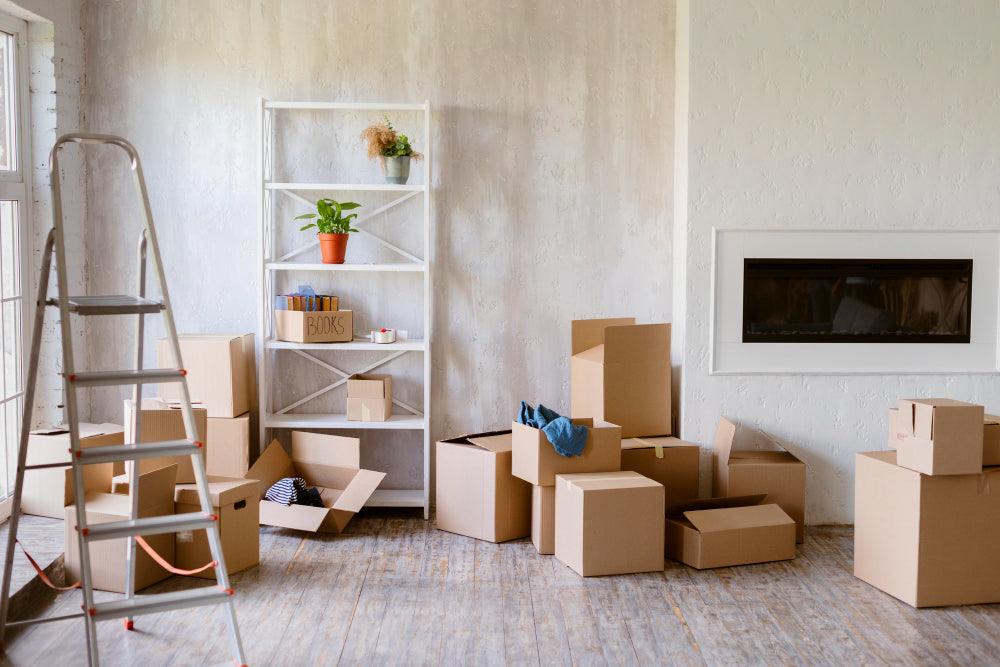The process can seem daunting as you retire and consider downsizing your home. It's an exciting time of life transition that comes with a mix of emotions (and the added challenge of figuring out exactly where to begin). Whether looking for ways to maximize your resources or make the most out of limited space, plenty of tips are available for seniors downscaling their homes.
Below, we’ll provide some helpful ideas that will make sorting through and organizing your possessions easier while ensuring that no detail is overlooked in ensuring this significant accomplishment runs as smoothly as possible.

Downsizing Tips for Seniors and Questions to Ask Yourself
Is it Time to Downsize? (Questions to Ask)
Downsizing can be a significant life decision, especially for seniors. It involves a change in living space and potentially a lifestyle change. Here are some essential questions that seniors should ask themselves as they consider downsizing their homes:
-
What are my primary motivations for downsizing?
- Financial reasons (reduce expenses, free up equity)?
- Physical reasons (ease of mobility, maintenance)?
- Lifestyle reasons (simplify, travel, community living)?
-
What type of housing arrangement will best suit my needs?
- Condo or apartment?
- Smaller house or cottage?
- Retirement community or assisted living facility?
-
How much space do I need?
- Consider the number of bedrooms, bathrooms, and common areas.
- Think about storage space for belongings.
-
What are my must-haves and deal-breakers for a new home?
- Proximity to amenities, family, or medical facilities.
- Access to public transportation or services.
-
How will downsizing impact my daily routine and lifestyle?
- Consider any changes in hobbies, social activities, or routines.
- Think about how the new space will facilitate or challenge your preferred way of living.
-
What will I do with my belongings?
- Decide what to keep, sell, donate, or pass on to family members.
- Consider the available storage in your new space.
-
Is this the right time to downsize?
- Consider factors like health, mobility, and family circumstances.
- Evaluate whether you're emotionally ready for this change.
-
What are the financial implications of downsizing?
- Calculate the costs of selling, moving, and purchasing a new home.
- Consider how downsizing will impact your monthly expenses.
-
How will downsizing affect my social connections?
- Consider proximity to friends, family, and social activities.
- Explore opportunities for community engagement in the new location.
-
What are the long-term plans for my new living situation?
- Consider whether this will be your forever home or a transitional step.
- Factor in potential future changes in health or living needs.
-
Have I thoroughly researched potential new homes?
- Visit properties, talk to neighbors, and explore the neighborhood.
- Consider the accessibility and safety of the new location.
-
Am I emotionally prepared for this transition?
- Acknowledge any feelings of attachment or nostalgia for your current home.
- Consider the potential benefits and positive aspects of the move.
Remember, downsizing is a personal decision, and what works best for one person may not be the right choice for another. Considering these questions carefully will help ensure the decision aligns with your needs, desires, and circumstances. Additionally, consulting with financial advisors, real estate professionals, and loved ones can provide valuable insights and support throughout the process.

12 Downsizing Tips for Seniors to Make The Whole Process Easier
Start Early
Starting the downsizing process early is vital for seniors. Begin by handling smaller tasks well ahead of your moving date. Thanks to this early start, you can reduce stress and make thoughtful decisions about what to keep and discard.
By gradually working through your possessions, you can prevent feeling overwhelmed and rushed during the final stages of downsizing. Additionally, this approach allows you to involve friends or family members, making the process more cooperative and doable.
Create a Plan
Developing a thorough downsizing strategy is an essential step (and also a first step) for older people who want to lessen their things and shrink their living space. Your plan should cover every aspect of downsizing, including organizing particular spaces and choosing the necessary belongings for your new home.
A carefully thought-out approach provides guidance and assistance, helping you stay on task and organized throughout the downsizing process. It makes choosing which items to keep, donate, or sell easier by allowing you to rank your assets (sounds fun, right?) according to their importance and sentimental value.
Make a Schedule
Setting a realistic timetable for your downsizing efforts is essential for successfully managing the procedure. Identify your intended moving date or the date to transition to a smaller living arrangement. Then, plan backward to establish a schedule that assigns specific tasks to different periods.
Having target dates for sorting through belongings, packing, and organizing logistics helps prevent delay and last-minute pressure as the move nears. A well-planned timeframe also allows for flexibility, allowing you to continue your downsizing journey despite unanticipated difficulties or changes in your circumstances.
Secure Treasured Possessions
When downsizing, protecting priceless and sentimental items should be your top priority. It is advisable to identify these precious belongings early on and store them in a secure, easily accessible place. These items, including treasured keepsakes, photos, or family heirlooms, can have incredibly high emotional worth.
Taking special care of these items guarantees they won't be accidentally discarded or misplaced. Designating a specific box or storage container for these beloved possessions may be helpful, clearly labeled to highlight their significance throughout your downsizing process.

Design the New Home's Floor Plans
Seniors should know how their possessions will fit in their new house before downsizing, which will help them plan their relocation. Measure the new home's measurements and draw out a thorough floor plan to do this. This layout will serve as a visual aid to assist seniors in determining which furniture and belongings can fit in their new setting.
Seniors can choose wisely what to bring, sell, donate, or repurpose by envisioning the layout. A thoughtful floor plan is helpful for downsizing and space optimization, especially for senior citizens.
Follow the “One Year” Rule
By adhering to the "One Year" rule, seniors can simplify the downsizing process by having a practical guideline for deciding which items to keep or let go of. If you haven't used or needed a particular item within the past year, consider it a candidate for downsizing.
This guideline enables older citizens to evaluate their assets in light of how well they fit into their present way of life, thereby minimizing emotional attachment to objects that may not be useful anymore. Seniors can declutter their new homes more efficiently and free up vital space for goods that improve their everyday lives by continuously adhering to this tip.
Stay Upbeat
For elders' emotional health during the downsizing process, maintaining a positive outlook is essential. Downsizing can be emotionally challenging, as it often involves parting with possessions that hold sentimental value. However, seniors can focus on the positive aspects of downsizing to ease the transition.
Accept the chance for a new beginning and a more spartan existence. Remind yourself of the advantages, including lower maintenance requirements, lower costs, and the opportunity to design a more streamlined and clutter-free living area. You can make the process of downsizing more enjoyable and successful by surrounding yourself with encouraging friends and family members.

Ask for Help
Seniors should quickly seek assistance from family members, friends, or professional organizers when downsizing. Asking for assistance can significantly reduce the process's physical and emotional strain. Family and friends are an excellent resource for advice on what to retain and what to discard, help with packing and even assistance with going through stuff.
Professional organizers offer knowledgeable advice and workable solutions, specializing in decluttering and downsizing. Reaching out to others for moral support or practical assistance can help seniors manage and cope with downsizing.
Consider Renting Storage Space
When faced with downsizing, seniors may come across possessions they are not ready to let go of but need immediate space in their new home. Storage providers like Juujbox have senior storage services that work perfectly for these use cases. These solutions provide a secure and convenient way to store cherished items that cannot be accommodated in downsized living quarters.
However, seniors need to approach box storage thoughtfully, with a well-defined plan, as excessive storage expenses can offset the financial advantages of downsizing. It is crucial to prioritize items placed in box storage based on their significance and ease of access.
Make 3 Piles
Simplify your downsizing process by sorting your possessions into three piles: keep, donate/sell, and discard. As you go through your belongings, assign each item to one of these piles based on its value and relevance to your new living situation.
The "keep" pile should include essentials and cherished items, while the "donate/sell" pile should contain items in good condition that can benefit others or generate some extra income. The "discard" pile should consist of damaged or no longer helpful items.
This straightforward sorting method makes it easier for seniors to make decisions, reduce clutter, and smooth the transition to a more simplified lifestyle.
Use Measurements to Guide Choices
To make informed decisions about which furniture and possessions to keep or let go of, rely on measurements. Measure both your current belongings and the available space in your new home. Using this method, you may be sure that the furniture and other objects you decide to keep will fit into your smaller home without discomfort.
You can find items that could be too big or unusable for your new location by comparing measurements, and then you can decide whether to keep, sell, or reuse them. Using measurements as a guide minimizes the risk of overcrowding and optimizes the use of available space in your downsized home.
Digitize Memories With Technology
To eliminate physical clutter while preserving the essence of these priceless memories, consider digitizing photographs, letters, and other sentimental artifacts. Scan and archive these items onto digital platforms or cloud storage to easily access and share them without taking up physical space.
You can also make digital scrapbooks or albums to arrange and savor these memories. Embracing technology not only helps you downsize but also makes sure that your special moments are still accessible and memorable in a way that is suitable for elderly citizens.

Final Thoughts
As a senior, moving into a smaller apartment can be a life-altering experience that results in a more manageable and satisfying living. Older individuals can move through the downsizing process confidently and comfortably if they start early, make a strategy, and follow valuable recommendations. It's all about preserving priceless memories, simplifying daily tasks, and welcoming a fascinating new stage of life.



